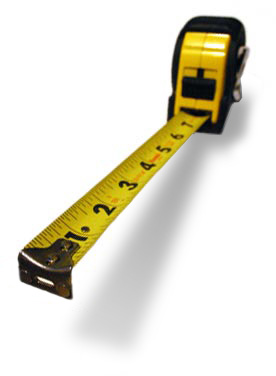 Are you and your organization ready for change?
Are you and your organization ready for change?
Too often organizations define the change effort they want to pursue without first identifying whether there are people, resources, legislation, etc. present that must be in place before the change effort can begin. We will explore the circumstances you may want to explore before beginning any change effort and the areas to explore as potential prerequisites to the change program and its eventual success.
During the course of any change initiative many different challenges will appear, and the most successful change efforts will anticipate those challenges and have a plan for dealing with them. Part of that anticipation begins with identifying how ready the organization is for change.
The Change Planning Toolkit™ is designed to assist your change planning team by making the planning process easier with its collection of 50+ frameworks, methodologies and other tools.
One of the keys to change planning success is carefully identifying the prerequisites for change, including:
- What must we know? (Knowledge)
- What must we have? (Tools)
- What must be completed? (Foundation)
This information is captured in one of the worksheets in the toolkit.
One other concept we should stop and discuss briefly is the idea of change saturation. This concept captures the idea that organizations in general, and certain individuals in specific, can only absorb so much change at one time. One frequent occurrence with change efforts is the situation where more than one project or larger change effort may require the same human, financial, physical, information or other resources at the same time. To become aware of this situation and to enable you to work to mitigate the effects of change saturation, you will want to build a heat map identifying the different timing, duration, and intensity of the different requirements all of the different projects and change efforts will place on the different types of resources within the organization. This too is a prerequisite.
Another prerequisite for change is having a deep understanding for what the current state looks like, including having answers for the following:
- Who is feeling the pain? Pushing for the change?
- What is the pain caused by the current state?
- Where is the bulk of the change likely to take place?
- When did the current state start causing pain?
- Why is the change being pursued
These questions can be asked and answered during your change planning session, but they must be asked and the answers must be integrated into your examination of your readiness for this change BEFORE you actually begin the change.
An additional prerequisite for change is also having a deep understanding for what the desired state will look like, including answers for the following:
- Who are we making this change for? Who will feel the greatest benefit from this change?
- Where will the resources and support come from?
- When do we need/want to complete the change process by? Is there a legal deadline?
- What solution would we like to see in place?
- Why is this solution better than the status quo?
Finally, to be ready to pursue a change the organization must have people in place to look after each of the Five Keys to Successful Change and should be familiar with both the Architecting the Organization for Change framework and my PCC Change Readiness Framework (these are three of the free downloads from the toolkit).
My PCC Change Readiness Framework focuses on the psychology of key groups surrounding the identified change, the capabilities needed to successfully execute the change, and the organization’s capacity to tackle this change effort (along with everything else).
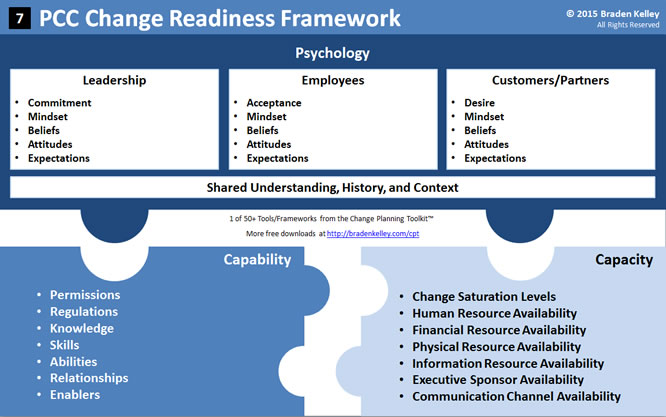
You will notice that I don’t speak about organizational psychology or culture in my PCC Change Readiness Framework. The reason I don’t highlight culture in the same way that many other people do is that in today’s more social, customer-centric business, we must look more broadly than the typical inward focus of company culture when it comes to identifying the readiness of not only employees, but leaders, customers, and partners too. Inevitably many of our change efforts will have some impact on one or more external groups (possibly even non-profit entities and one or more governments).
You will notice that within the PSYCHOLOGY box there is a common focus on the mindsets, attitudes, beliefs and expectations of the individuals. Culture is incorporated into the psychology realm by focusing on what the shared understandings are around the potential change, but more broadly too. And, finally you will notice that my PCC Change Readiness Framework highlights the need for successful change efforts to move towards gaining commitment to the change from leadership, acceptance of the change by employees, and a desire for the change from customers and partners.
Within the CAPABILITY box of my PCC Change Readiness Framework we must investigate whether our change effort has any regulatory or statutory implications and whether we are ready to adapt, adopt or influence the changes necessary in this sphere. We must also ask ourselves a series of questions:
- “Do we need to get permission from anyone to do this?”
- “What knowledge, skills, and abilities needed for this change do we already possess?”
- “What knowledge, skills, and abilities needed for this change do we need to acquire?”
- “What relationships do we possess that will be useful in advancing the change?”
- “What relationships do we need to build to help advance the change?”
- “What are the enablers of making this change successful?”
Within the CAPACITY box we have to look at where our resources are approaching, or have already achieved, change saturation. This means they are unable to productively participate in any more change efforts or adopt any more change. But we also have to look at the availability of our resources:
- Human
- Financial
- Physical
- Information
- Executive Sponsors
- Space in our desired communication channels
It is easy to take for granted that the organization will have the capacity to undertake your change effort, but often there are capacity constraints that you will run into, especially as the pace and volume of change increases inside an organization. The one that is easiest to overlook and fail to plan for, is making sure that you’re going to be able to communicate your change messages in your desired messaging channels (they may already be full).
There is a worksheet that goes with the PCC Change Readiness Framework that will help you capture information around the:
- History
- Capability
- Capacity
- Partners
- Context
- Leadership
- Employees
- Customers
- Shared Understanding
- Strategic Alignment (Commitment)
- Cultural Alignment (Acceptance)
- Brand Alignment (Desire)
EDITOR’S NOTE: I’ve gone ahead and created a free downloadable flipbook PDF for people to grab. It was inspired by Braden’s article titled Change the World – Step Two, which was the follow-up predictably to Change the World – Step One.

You will find these companion tools for the PCC Change Readiness Framework in the Change Planning Toolkit™ to download for printing and use in your collaborative exploration of your change readiness.
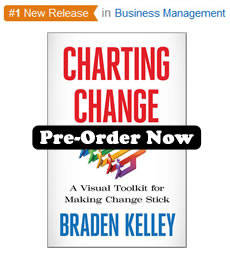 In my next book Charting Change we will investigate additional aspects of change readiness and have a special section from one of my invited guest experts in the book, Beth Montag Schmaltz of PeopleFirm looking at several topics including change fatigue, where the change threshold lies, why people resist change, how to reduce change fatigue, how to build change capability, what change capable employees look like, and how you can embed change behavior into the very fabric of your organization.
In my next book Charting Change we will investigate additional aspects of change readiness and have a special section from one of my invited guest experts in the book, Beth Montag Schmaltz of PeopleFirm looking at several topics including change fatigue, where the change threshold lies, why people resist change, how to reduce change fatigue, how to build change capability, what change capable employees look like, and how you can embed change behavior into the very fabric of your organization.
The book is available for pre-order, and has received several strong endorsements, so I hope you’ll pick up a copy (or one for each member of your team). You can find more information on the Charting Change book page.
 Sign up here to get Human-Centered Change & Innovation Weekly delivered to your inbox every week.
Sign up here to get Human-Centered Change & Innovation Weekly delivered to your inbox every week.

![]() Sign up here to get Human-Centered Change & Innovation Weekly delivered to your inbox every week.
Sign up here to get Human-Centered Change & Innovation Weekly delivered to your inbox every week.
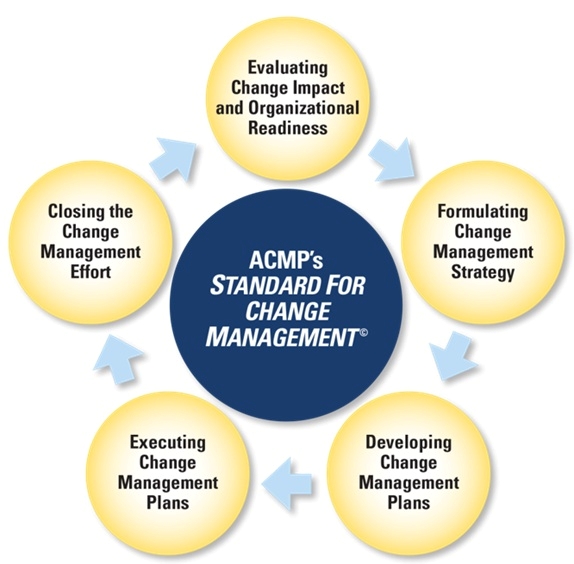
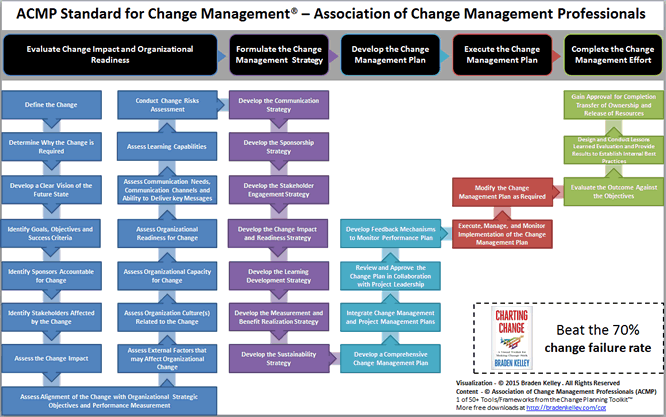

 Are you and your organization ready for change?
Are you and your organization ready for change?

